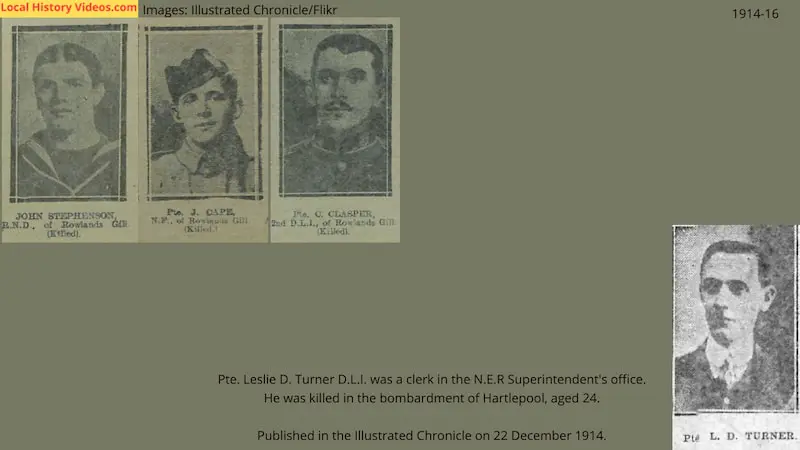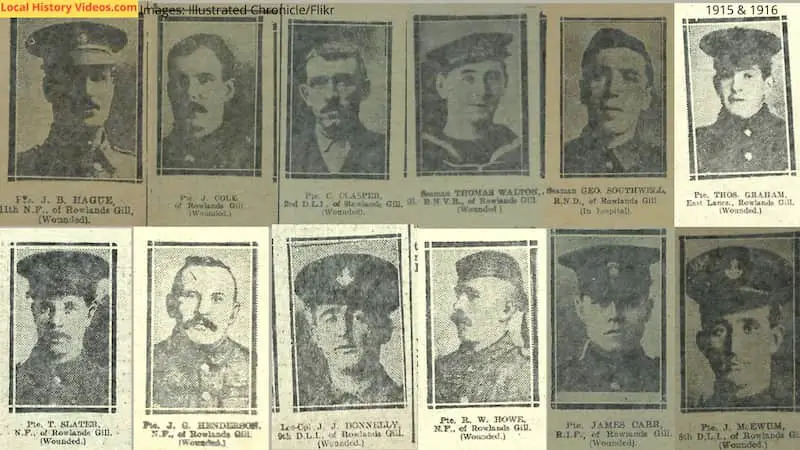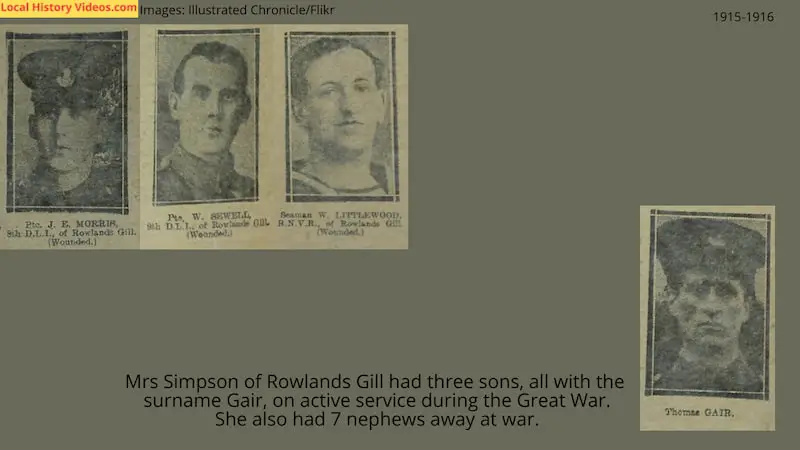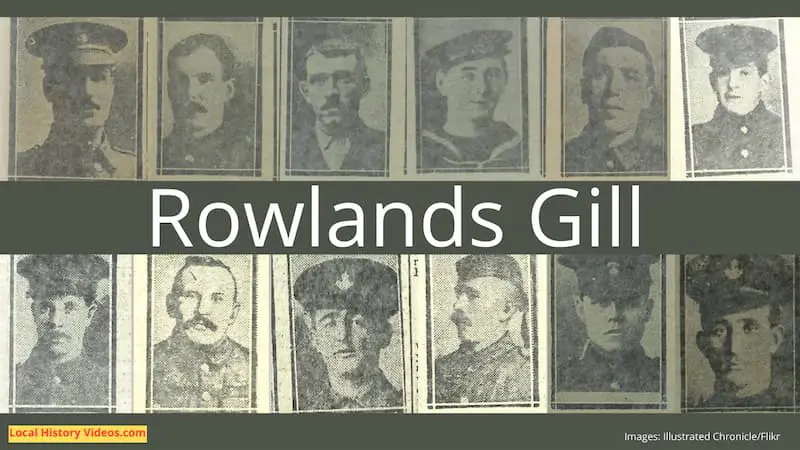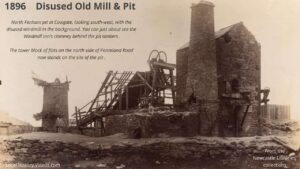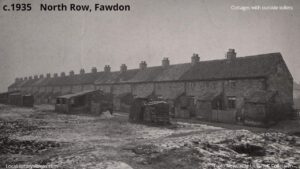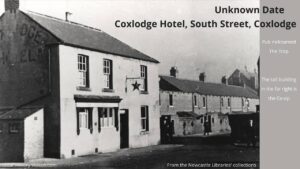A glimpse of history at Rowlands Gill, in North East England.
The small town of Rowlands Gill seems to have been rarely photographed or filmed in the past, and usually omitted from old maps. But we can glimpse some of the local history through books published back in the 19th century.
Extract from:
“General Report … to the Board of Trade Upon the Accidents which Have Occurred on the Railways During the Year 1872“
“21st December . – A passenger train following another passenger train came into collision with it between Swalwell and Rowland’s Gill stations.
Ninety passengers complained of having been bruised, shaken, or otherwise injured.
There was said to have been an interval of five minutes between the trains leaving Swalwell. The failure of a new engine with the first train, and the failure of the guard to go back to warn the second train, appears to have
led to the collision.
This collision was one of a class which system would be invaluable for pre the absolute block venting.”
Extract from
“A Treatise Upon Railway Signals and Accidents” by Archibald Davis Dawnay
Page 72:
Published 1874
“Two passenger trains came into collision during a fog at Barnwood , near Cheltenham, whereby 25 persons were hurt; also between Smallwell and Rowlands Gill stations, from which 90 persons complained of injury, the two trains were started within five minutes of each other; and 22 persons were injured at Wormald Station.”
Extract from “The Road Coach Guide“
Published 1894
Gibside, the seat of the Strathmore family, stands out in bold relief; but the house, somewhat severe in style, has not been inhabited for some years. The monument seen towering above the trees is that of Liberty. A mile farther on we reach ROWLANDS GILL, where fresh horses are requisitioned, the pretty surroundings of this old-time country inn the “Tounely Arms” – being very noticeable.
The road now winds along the side of the hill, overhung with trees, to LINTZ FORD , the Derwent winding away at our feet some three hundred feet below.
Extract from:
“History of the Parish of Ryton” by William Bourne (of Whickham).
Published in 1896
Pages 162 & 163:
St Patricks Church… “A branch road near the church enters Smailes’ Lane, which terminates near to Rowlands Gill Station.
It was at the bottom of Smailes’ Lane, after crossing the Shotley Bridge turnpike, that Mr. Robert Stirling, assistant to Dr. Watson of Burnopfield, was murdered on the 1st of November, 1855. He had been little more than a week in the service of Mr. Watson, and was returning from visiting the patients of that gentleman, when he was shot by some persons lurking near the road, his throat cut, and his head and face frightfully injured, apparently by the butt end of a gun. His watch, money, and lancets were taken from his pockets, and the body was dragged through a fence and deposited among the bushes in a plantation which covered a steep declivity, where it was not discovered till about a week afterwards.
A considerable sensation was excited throughout the county by this atrocious deed, and large rewards were offered for the discovery of the perpetrators. Two men, named John Cain, the proprietor of an illicit still in the neighbourhood, and Richard Rayne, a blacksmith at Winlaton, were apprehended on suspicion, and brought up at the Durham Spring Assizes in 1856, but the evidence not being complete, they were remanded to the Summer Assizes in July of that year. After a prolonged trial, in which a variety of circumstantial evidence was adduced on behalf of the prosecution, a verdict of Not Guilty was returned.
Rowland Gill derives its name from Robert Rowland, who possessed lands there in 1621, and Gill , a north-country word for rivulet.
About a quarter of a mile eastward of Rowlands Gill Station is the Lily Drift, belonging to Messrs. Joseph Cowen & Co. The workmen live in a row of houses at the west side, at the end of which there is a neat Primitive Methodist Chapel, erected in 1883, and capable of seating 200. The coals are now drawn by an endless rope to the screens at Blaydon Burn, after which they are sent to Blaydon and conveyed by wherries to their destination.”
“Transactions of the Royal English Arboricultural Society“, Volume II, by the Royal English Arboricultural Society
Published 1896
Page 229:
“By the kind permission of the Earl of Strathmore, the members of the English Arboricultural Society visited the estate of Gibside on Thursday, October 6th, 1892, reaching Rowlands Gill station, which closely adjoins the estate, about one o’clock.
As the annual meetings are held in different parts of the country, and must necessarily be at a considerable distance from many local centres, it has been thought that the local secretaries in these centres might quicken the interest of the members and increase the usefulness of the society by organising subsidiary excursions in their respective localities.”
Page 244:
“The demand for timber consequent upon the French war, was assigned by Mr. Robinson as a reason for the increase in the price of Oak….
Having left the grounds, the party returned to the inn at Rowlands Gill, where an excellent repast was provided for them by the
hostess.”
Report, Volume 16, Commonwealth Shipping Committee
Published 1897
The records on Page 159 show that on 28 July 1879, at Rowlands Gill pit, two miners were injured, one fatally, by the gunpowder they were laying into a hole.
Then on page 160 we learn that on 25th August 1880, “A miner, named William Davison, was preparing to fire a shot with compressed gunpowder. He had a candle near which fell into a broken cartridge and caused it to explode, whereby Davison was injured on his face, hands, and legs, but not seriously. “
War Casualties
During the Great War, which later became known as World War I, the Illustrated Chronicle published the names of men wounded, missing or killed in service, accompanied by the photos sent in by close relatives.
It’s an invaluable record, given that over the years many of these old photos will have been lost or damaged, or the identity of the young men pictured long forgotten.
The next three images show some of the men of Rowlands Gill who died, went missing in action, or were wounded, from late December 1914 to mid 1916.
For such a short space of time, and given the variety of destinations these soldiers and seamen headed to, it’s astonishing that a tiny settlement lost, or came so close to losing, so many of its young men.
The Newcastle Libraries’ Service uploaded these old photos to Flikr, where you can find out the date of publication, sometimes the age of the missing and deceased, and occasionally additional information. If you have any further information about the young men pictured, they would love to hear from you.
